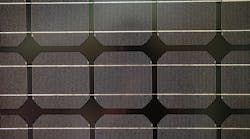There are two main schools of thought when it comes to solar power. The first involves using solar cells that create an electric current when sunlight strikes the layers of semiconductor material. The second entails gathering heat from concentrated beams of sunlight, then converting the heat into electricity by using it to spin turbines.
There is, however, a third approach that exploits both light and heat. Scientists from the Massachusetts Institute of Technology recently invented such a solar cell in an attempt to make it vastly more efficient at converting energy. Their work, which appeared in the journal Nature Energy, is some of the latest in the tongue-twisting field of solar thermophotovoltaics (STPV), which has long been predicted to improve efficiency by leaps and bounds.
These solar cells contain layers of specialized material that absorb sunlight, store it as thermal energy, and then emit that heat in the form of light. By configuring the layers of material in different ways, the resulting light can be tuned to specific wavelengths. An underlying layer of silicon—a traditional solar cell—can then convert that secondary light into electric current. In theory, the result is that the entire system has a higher efficiency than traditional solar cells would have alone.
The MIT scientists went a few steps further with their research. When the research team compared solar cells enhanced with STPV components and normal solar cells, both in direct sunlight and cloudy conditions, it found that their system could more than double the theoretical limit on solar cell efficiency.
That threshold, known as the Shockley-Queisser Limit, has been an imposing wall for researchers since it was calculated by transistor inventor William Shockley and Hans-Joachim Queisser in 1961. For a single-layer cell made of silicon, the limit is about 32 percent efficiency. Typical solar panels today are between 10 and 20 percent efficient.
“With solar thermophotovoltaics you have the possibility to exceed that,” said MIT doctoral student David Beirman, who worked on the new solar cell. With the demonstration, “we showed that just with our own unoptimized geometry, we in fact could break the Shockley-Queisser limit,” he added. The new solar cell could generate twice as much power from a given area of solar panels, which are composed of silicon cells.
New advances in solar thermophotovoltaics have been spotty over the years. Finding the best materials for this process—those which emit solar energy within specific wavelengths and withstand high temperature—has been the main obstacle for scientists.
Within the new solar cell, the research team used a combination of carbon nanowires and an exotic material known as nanophotonic crystals. Several scientists working on the current project, including associate professor of mechanical engineering Evelyn Wang and physics professor Marin SoljaÄiÄ, have been studying the combination since early 2014, when it showed potential to absorb virtually all wavelengths of light. Normally, silicon only reacts with certain photons of light, while others are wasted.
The nanowires absorb nearly all the photons within the sunlight, which has been concentrated into a narrow beam through a series of mirrors. The sunlight heats the material and once it hits 1000°C, the crystals emit wavelengths of light that the underlying solar cell can react with. An advanced optical filter reflects back any unwanted wavelengths, which are absorbed into the crystals to maintain its heat.
Other kinds of solar cells have reached efficiencies over 40 percent, but only by using multiple layers of cells that can absorb a wider swathe of the visible light spectrum. The problem is that these multi-junction solar cells have complex structures, which are so expensive that they have been limited to satellites and other spacecraft.
Because the new research involves crystalline silicon, the most prevalent and cheapest material for solar cells, the new design could eventually translate into cheaper solar panels. It could also be more effective at generating electricity in cloudy weather, since it uses heat rather than direct sunlight. The next step for the research, said Beirman, is finding ways to scale up the laboratory prototypes and produce them cheaply.
Looking for parts? Go to SourceESB.

